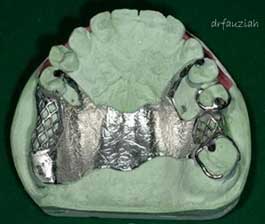Introduction
Dentures are removable appliances that replace missing teeth and surrounding tissues.
Types of dentures
There are three types of dentures available – partial, complete and overdenture.
-
- Partial Denture
Partial denture is a prosthesis that replaces some teeth in a partially dentate arch.

 An upper partial acrylic denture
An upper partial acrylic denture
- Partial Denture
-
Complete denture
Complete denture is a prosthesis that replaces all the natural teeth and associated structures of the maxilla and the mandible.
-
Overdenture
An overdenture is a complete or removable partial denture that has one or more tooth roots to provide support. Rather than extracting all non-functional teeth, the crowns and pulpal tissue of selected teeth are removed. The remaining root projecting through the mucosa is restored and contoured.

 Two anterior teeth prepared as overdenture abutments.An overdenture inside the mouth. The denture covers the two overdenture abutments.
Two anterior teeth prepared as overdenture abutments.An overdenture inside the mouth. The denture covers the two overdenture abutments.
Types of denture materials
- Acrylic denture: Acrylic denture consists of replacement teeth that are set in pink or gum colored acrylic resin. To aid the retention of the denture, one or more wire clasps are placed around the natural teeth in the mouth. This type of denture covers more tissue, a little bit thicker than Cobalt Chromium denture and easy to fracture.
- Cobalt Chrome denture: The framework in this type of partial denture is made from an alloy of cobalt and chromium; the false teeth will be attached to the framework with acrylic. They are thinner, much stronger than acrylic denture and lighter to wear; but have higher manufacturing costs.
 |
 |
|
An upper partial Cobalt Chrome framework
|
The Cobalt Chrome denture in the mouth
|
Why do you need a denture?
Replacing missing teeth with a denture will make it easier for you to chew food and speak clearly than you could without teeth. When you lose your teeth, facial muscles can sag, making you look older. Dentures can help fill out the appearance of your face and profile. Dentures may even improve the look of your smile and help boost your self-confidence. Dentures also prevent drifting of neighboring teeth towards the empty space created by tooth loss.
How are dentures made?
You can go to a government dental clinic or a private dental clinic to make a denture. The denture construction process takes about 3 to 6 appointments. Once your dentist determines which type of denture is the best for you, the general steps are :
- On the first appointment the dentist will examine the oral condition and make primary impressions. Primary impressions are taken for diagnostic purposes and to aid in designing the new denture.
- The dentist will then make necessary preparation on the teeth according to the denture design, and takes a second set of impressions. This step ensures optimal impression accuracy so that the resulting fit of the denture is excellent.
- Bite registration: This step is to take measurements of how your jaws relate to one another and how much space is between them.
- The try-in stage: At this stage, a preliminary set of dentures are constructed made out of wax, they are meant to give you a chance to “try on” the new dentures and see what they will look like before processing the wax denture base into hard acrylic. You will “try in” this model and the denture will be assessed for color, shape, and fit before the final denture is made.
- Issue stage: The finished denture is inserted in the mouth and necessary adjustments made until the patient feels comfortable wearing the new denture. Instructions will be given on cleaning the remaining teeth and also on how to clean the denture.
- Review stage: This appointment is to ensure that the oral tissues are not being damaged and that the dentures are functional.
Wearing dentures for the first time
New dentures may feel awkward for a few weeks until you become accustomed to them. Speaking and eating may feel different with dentures. The dentures may feel loose while the muscles of your cheek and tongue learn to keep them in place. You may experience minor irritation or soreness and find that saliva flow increases. As your mouth becomes accustomed to the dentures, these problems should go away. If any problem persists, particularly irritation, soreness or ulceration, be sure to consult your dentist. Follow-up appointments with the dentist are generally needed after a denture is inserted so the fit can be checked and adjusted.
Tips for denture wearers
For the first few days of wearing dentures, you can start with soft food. You can also cut your food into small pieces. Reading aloud for the first couple of days will help you to overcome speech problems. Your speech will improve as your tongue and mouth muscles adjust to your denture. Denture adhesives may be helpful while you are getting used to your new denture. If you experience pain, do not use the denture temporarily and visit your dentist as soon as possible.
How to care for your denture
Brush and rinse your denture after meals and before bed. Soak in a glass of clean water when not using or during bed time. Do not use hot or warm water. Do not attempt to alter or repair the denture yourself. Dentures should not be worn at night.

Brush and rinse your denture after meals and before bed.
Reference
Davenport JC, Basker RM, Heath JR, Ralph JP & Glantz PO. (2000). A Clinical Guide To Removable Partial Dentures. London: British Dental Association.
| Last reviewed | : | 29 November 2012 |
| Writer | : | Dr. Fauziah bt. Ahmad |
| Accreditor | : | Dr. Isma Liza bt. Ali |
| Reviewer | : | Dr. Roshima bt. Mohd Sharif |







